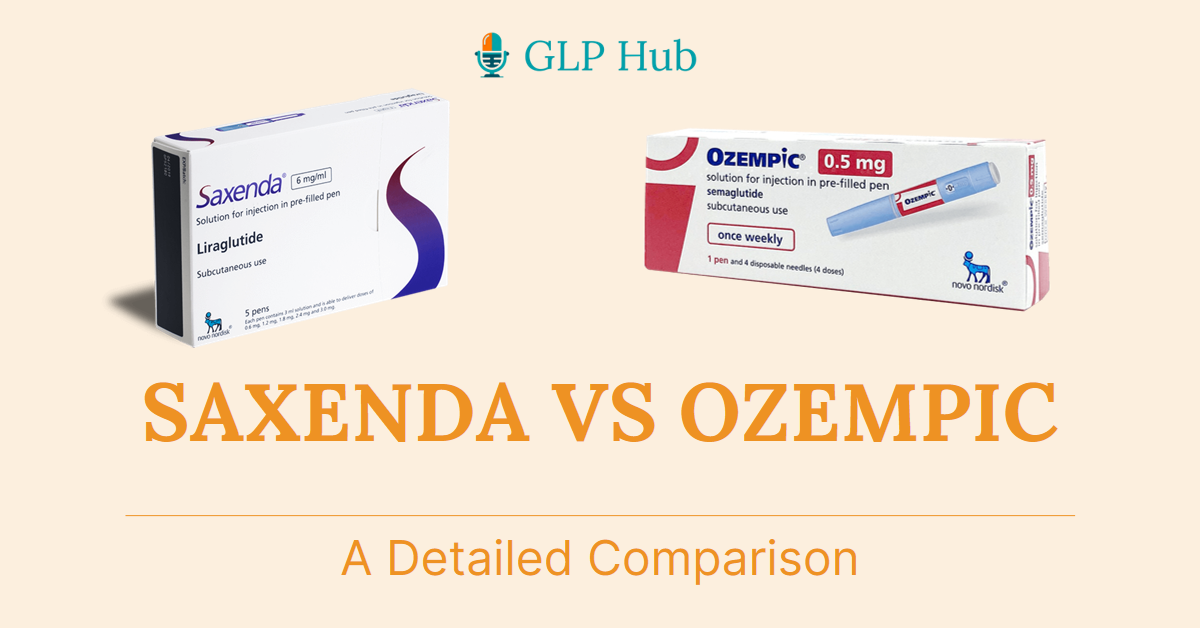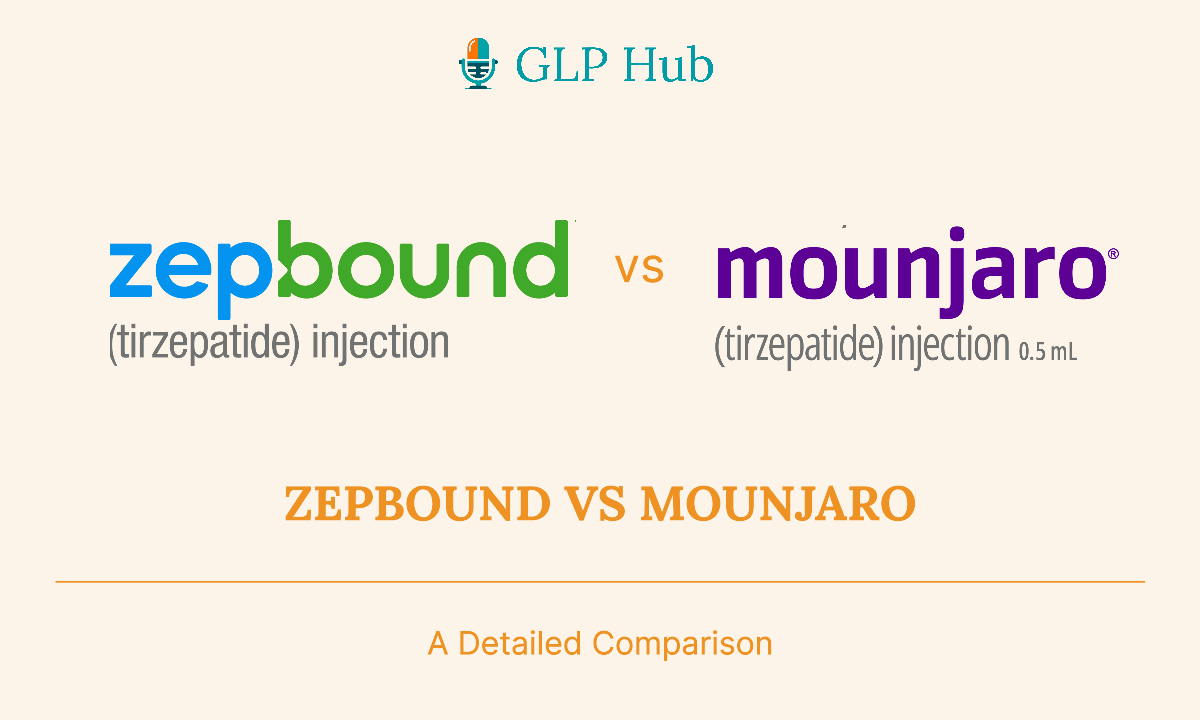Introduction
In the quest for effective weight loss solutions, the importance of choosing the right medication cannot be overstated. This blog post aims to provide a detailed comparison between Saxenda and Ozempic, shedding light on their mechanisms, effectiveness, side effects, costs, and real-world patient experiences.
Among the myriad of options available, Saxenda and Ozempic have emerged as two of the leading prescriptions recommended by healthcare professionals. These drugs, while similar in their goals, offer distinct approaches and outcomes for weight management.
Whether you’re considering these medications for yourself or seeking information for a loved one, our comprehensive analysis will guide you through each aspect, helping you make an informed decision in your weight loss journey.
What Are Saxenda and Ozempic?
In the landscape of weight loss medications, Saxenda and Ozempic stand out not only for their effectiveness but also for their unique mechanisms of action. Both drugs are injectables, a factor that might influence patient preference and treatment adherence. Understanding these medications begins with exploring what they are and how they work.
Saxenda (Liraglutide)
Saxenda is a brand name for liraglutide, a medication originally developed to manage diabetes but has since gained approval for weight loss.
It is classified as a GLP-1 receptor agonist, which means it mimics the action of the glucagon-like peptide-1 (GLP-1) hormone in the body. This hormone is involved in appetite regulation and calorie intake. By activating GLP-1 receptors, Saxenda slows gastric emptying, promotes a feeling of fullness, and reduces appetite, leading to a decrease in calorie intake and, consequently, weight loss.
Saxenda is administered through a daily injection, making it a part of the patient’s routine in their weight management journey.
Ozempic (Semaglutide)
Similar to Saxenda, Ozempic is also a GLP-1 receptor agonist but with semaglutide as its active ingredient. Initially approved for the treatment of type 2 diabetes, Ozempic has demonstrated significant efficacy in weight loss, leading to its endorsement for this use as well.
Ozempic works by enhancing insulin secretion, suppressing appetite, and decreasing glucagon secretion in a glucose-dependent manner. Its effect on slowing gastric emptying and reducing appetite contributes to weight loss.
Ozempic’s dosing schedule is once weekly, which may offer a convenience advantage over daily injections for some patients.
Both medications leverage the body’s natural systems to aid in weight management, offering a pharmacological approach to complement lifestyle changes such as diet and exercise. However, despite their similarities, there are differences in their approval, indications, and usage that are important for patients and healthcare providers to consider when choosing a weight loss strategy.
The choice between Saxenda and Ozempic often comes down to individual factors such as medical history, lifestyle considerations, and the specific recommendations of a healthcare provider.
Approval and Indications
Understanding the regulatory approval and indications for use of weight loss medications is crucial for patients and healthcare professionals alike. Both Saxenda and Ozempic have undergone rigorous evaluation by the Food and Drug Administration (FDA) in the United States, highlighting their safety and efficacy for specific uses.
Let’s review the approval history and indications for Saxenda and Ozempic to clarify their roles in weight management.
Saxenda (Liraglutide 3.0 mg): Saxenda received FDA approval in December 2014 specifically for weight management. It is indicated for adults with a body mass index (BMI) of 30 kg/m² or higher (obese) or 27 kg/m² or higher (overweight) in the presence of at least one weight-related condition such as hypertension, type 2 diabetes, or dyslipidemia.
Saxenda is also approved for use in adolescents aged 12-17 years with a body weight above 60 kg and an initial BMI corresponding to 30 kg/m² or more for adults. The approval was based on the results from multiple clinical trials demonstrating significant weight loss when combined with a reduced-calorie diet and increased physical activity.
Ozempic (Semaglutide): Originally approved by the FDA in 2017 for the treatment of type 2 diabetes, Ozempic has also shown significant efficacy in weight loss, which led to the approval of a higher dose under the brand name Wegovy for chronic weight management in June 2021.
For weight management, it’s indicated for adults with a BMI of 27 kg/m² or higher who have at least one weight-related ailment or in individuals with a BMI of 30 kg/m² or higher. The approval of semaglutide for weight management was supported by a series of clinical trials showcasing its ability to help patients achieve and maintain weight loss when used alongside diet and exercise.
Both drugs are part of a broader category of GLP-1 receptor agonists, with their approval for weight management marking a significant advancement in the treatment of obesity and overweight conditions with comorbidities. However, it’s important to note that neither Saxenda nor Ozempic is intended as a first-line treatment for weight loss. They are recommended for patients who have not achieved significant weight loss through diet and exercise alone.
The distinct approvals and indications for Saxenda and Ozempic underscore the importance of personalized medical advice when considering these medications for weight loss.
Efficacy for Weight Loss
When comparing Saxenda and Ozempic, one of the most critical aspects for patients and healthcare providers is their efficacy in promoting weight loss. Both medications have been the subject of numerous clinical trials, offering a wealth of data on their ability to help individuals lose weight. This section delves into the findings from these studies, providing insight into what patients might expect in terms of weight loss outcomes.
Saxenda (Liraglutide 3.0 mg): The efficacy of Saxenda for weight management has been demonstrated in several key studies, most notably the SCALE (Satiety and Clinical Adiposity – Liraglutide Evidence) trials. These trials evaluated the drug’s performance in different populations, including those with type 2 diabetes and those without. Across the board, Saxenda has shown to lead to a significant reduction in body weight.
On average, participants in the SCALE trials lost approximately 5% to 10% of their body weight. The most significant weight loss was observed in individuals without diabetes, highlighting the drug’s potential as a powerful tool for weight reduction in a broad patient population.
Ozempic (Semaglutide): Semaglutide’s weight loss efficacy has been evaluated in the STEP (Semaglutide Treatment Effect in People with obesity) clinical program among others. These studies have demonstrated that, similar to Saxenda, Ozempic can lead to significant weight loss.
In the STEP trials, participants receiving semaglutide experienced an average weight reduction of approximately 10% to 15% of their initial body weight. The highest weight loss was observed in participants who were administered the higher doses intended for weight management (as marketed under the brand name Wegovy for obesity treatment), showcasing the dose-dependent efficacy of semaglutide in weight reduction.
Both Saxenda and Ozempic operate by mechanisms that not only reduce appetite but also control blood sugar levels, contributing to weight loss. However, the data suggests that the average weight loss with Ozempic may be slightly higher than with Saxenda, though individual results can vary widely based on factors such as adherence to the medication, lifestyle changes, and baseline body weight.
Weight Loss Results with Ozempic and Saxenda: Comparing Trial Data
Data suggests that the average weight loss with Ozempic may be slightly higher than with Saxenda.
Participants in Saxenda’s trial lost 5% to 10% of their body weight. Participants in Ozemipic’s trial lost 10% to 15% of their initial body weight.
It’s also worth noting that the weight loss achieved with these medications is most significant when combined with lifestyle modifications, including diet and exercise. Moreover, the sustainability of weight loss is an important consideration, with ongoing treatment potentially required to maintain the weight loss over time.
Side Effects and Safety
When considering weight loss medications like Saxenda and Ozempic, understanding the potential side effects and safety profiles is crucial for making an informed decision. Both medications, as GLP-1 receptor agonists, share similar side effect profiles, but there are nuances in their safety considerations that patients and healthcare providers need to be aware of.
Saxenda (Liraglutide 3.0 mg): The most common side effects associated with Saxenda include gastrointestinal issues such as nausea, diarrhea, constipation, vomiting, and abdominal pain. These side effects are generally mild to moderate in intensity and tend to decrease over time as the body adjusts to the medication. Saxenda can also cause increased heart rate and should be used with caution in patients with a history of cardiovascular disease. Rarely, it has been associated with more serious conditions, including pancreatitis, gallbladder disease, and thyroid tumors, including medullary thyroid carcinoma (MTC). Patients need to be monitored for symptoms of these conditions and for changes in heart rate.
Ozempic (Semaglutide): Similar to Saxenda, the most common side effects of Ozempic are gastrointestinal in nature, including nausea, vomiting, diarrhea, abdominal pain, and constipation. Ozempic has also been associated with a risk of pancreatitis and changes in vision due to diabetic retinopathy complications. Like Saxenda, there is a warning for thyroid C-cell tumors, and it is contraindicated in patients with a personal or family history of MTC or Multiple Endocrine Neoplasia syndrome type 2 (MEN 2). Patients should be vigilant for signs of pancreatitis and seek immediate medical attention if symptoms occur.
Both medications require careful consideration of their side effect profiles, and patients should be counseled on the importance of reporting any adverse reactions to their healthcare provider. Additionally, both Saxenda and Ozempic carry warnings regarding potential thyroid tumors, including MTC, which necessitates a careful assessment of patient history and monitoring for symptoms indicative of thyroid cancer.
The risk of side effects must be balanced against the benefits of weight loss, which can significantly reduce the risk of heart disease, diabetes, and other obesity-related conditions. The decision to use Saxenda or Ozempic should be made in consultation with a healthcare provider, taking into account the patient’s medical history, the potential for side effects, and the overall risk-benefit profile of the medication.
Comparisons and Considerations
This detailed comparison of Saxenda and Ozempic reveals two highly effective options for individuals seeking medical assistance with weight loss. Both medications, rooted in the GLP-1 receptor agonist family, offer a modern approach to managing obesity and related health conditions. However, as we’ve explored, they come with their own set of characteristics, from their mechanisms of action and efficacy to their side effect profiles and administration schedules.
Saxenda, with its daily injection schedule, may appeal to those seeking a steady routine and has shown significant results in weight loss trials, especially among non-diabetic populations. Its ability to reduce appetite and increase feelings of fullness can lead to meaningful weight loss, with most users experiencing a reduction in body weight ranging from 5% to 10%. However, potential users must consider its side effects, particularly gastrointestinal discomfort, and rare but serious risks like pancreatitis and thyroid tumors.
On the other hand, Ozempic, administered weekly, offers convenience and has demonstrated slightly higher average weight loss outcomes in clinical trials, making it a compelling choice for many. Like Saxenda, it too requires users to navigate side effects, primarily gastrointestinal, and be aware of its contraindications, especially regarding thyroid cancer risks.
Conclusion
The decision between Saxenda and Ozempic involves a comprehensive evaluation of individual health profiles, lifestyle considerations, and personal preferences. Importantly, this decision should always be made in consultation with healthcare professionals who can provide personalized advice and support throughout the weight loss journey.
It’s also crucial to remember that these medications are most effective when used in conjunction with lifestyle modifications, including a healthy diet and regular physical activity. The ultimate goal is not just weight loss but the improvement of overall health and well-being.
FAQ: Saxenda vs. Ozempic for Weight Loss
What are Saxenda and Ozempic, and how do they work for weight loss?
Saxenda (liraglutide) and Ozempic (semaglutide) are GLP-1 receptor agonists used for weight management. They work by mimicking the GLP-1 hormone, which helps regulate appetite and calorie intake, leading to weight loss. Saxenda is administered daily, while Ozempic is a once-weekly injection.
Are Saxenda and Ozempic FDA-approved for weight loss?
Yes, both medications are FDA-approved for weight loss. Saxenda received approval in December 2014, and Ozempic, initially approved for type 2 diabetes in 2017, was later approved for weight loss at a higher dose under the brand name Wegovy in June 2021.
How effective are Saxenda and Ozempic in promoting weight loss?
Clinical trials have shown that Saxenda can help individuals lose approximately 5% to 10% of their body weight, while Ozempic has shown to lead to an average weight reduction of about 10% to 15%. Results vary based on several factors, including adherence to the medication and lifestyle changes.
What are the common side effects of Saxenda and Ozempic?
Both medications can cause gastrointestinal side effects, such as nausea, diarrhea, and abdominal pain. They also carry risks of more serious conditions like pancreatitis and thyroid tumors. The specific side effect profile for each drug should be discussed with a healthcare provider.
Can Saxenda and Ozempic be used together for weight loss?
Saxenda and Ozempic are not typically used together for weight loss. Healthcare providers will recommend the most appropriate medication based on individual health needs, weight loss goals, and medical history.
How do I choose between Saxenda and Ozempic for weight management?
Choosing between Saxenda and Ozempic involves considering factors such as the medication’s efficacy, side effect profile, dosing schedule, and personal health conditions. Consultation with a healthcare provider is essential to determine the best option for your specific situation.
Do I need to change my diet and exercise routine while taking Saxenda or Ozempic?
Yes, both Saxenda and Ozempic are most effective when used in conjunction with a healthy diet and regular physical activity. Lifestyle modifications are a critical component of achieving and maintaining weight loss.
How long do I need to use Saxenda or Ozempic to see results?
Weight loss results can vary, but most people begin to see significant weight loss within the first few months of treatment. Continuous use, as advised by a healthcare provider, is important for maintaining weight loss.
Are there any contraindications for using Saxenda or Ozempic?
Yes, both medications have contraindications, including a history of medullary thyroid carcinoma or Multiple Endocrine Neoplasia syndrome type 2 for both drugs. A healthcare provider can provide a complete list of contraindications based on your health history.
How can I decide if Saxenda or Ozempic is right for me?
Deciding if Saxenda or Ozempic is right for you involves a detailed discussion with your healthcare provider, considering your weight loss goals, medical history, potential side effects, and lifestyle. It’s important to make an informed decision based on professional medical advice.





